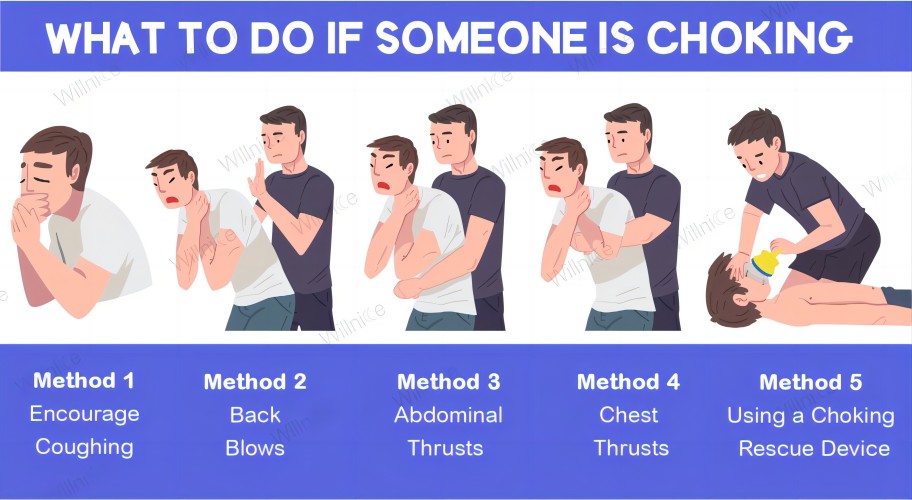
In emergencies, understanding how to effectively perform choking first aid can be the difference between life and death. This blog post aims to equip readers with essential knowledge and skills to handle choking incidents confidently. We will delve into the signs and symptoms of choking, enabling readers to identify when someone is in distress quickly. The article will also cover step-by-step instructions on performing the Heimlich Maneuver—the well-known and highly effective technique used to dislodge obstructions from a person’s airway. By the end of this post, readers will be empowered with the vital skills necessary to act swiftly and accurately during such critical moments.
What are the Signs and Symptoms of Choking?
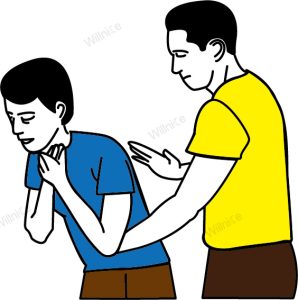
Choking can be defined in different ways or hat various manifestations. In such situations, the most visible symptom would be the shock of not being able to breathe. Another such major sign of choking would be holding the neck area. A gag reflex or very weak coughing and a pale or bluish skin may also be witnessed in the person. Also, that person may not be able to verbally communicate in a normal way, rather they may have development of high raspy breathing sounds or redness on their face. The most important thing is to be able to recognize these symptoms in time. This would prevent the delay in the provision of the necessary first aid treatment.
Recognizing the Symptoms of Choking
I can be an indicator of my ability to speak. For example, if I have the impression that I am having trouble inhaling or even worse, I am unable to take an inhalation, I tend to understand that I am in a state of choking. There is a possibility that I start instinctively to grab my neck in which case it is possible to assert my being in trouble. At times, whether strong or weak coughing could be experienced as my body trying to persist to remove the blockage. In the absence of sufficient oxygen, it is probable that my skin may turn pale or bluish, and I may have trouble articulating. On the other hand, my throat may make high pitch sounds together with trying to take a breath and my face may become red but there is no actual breathing produced. Such signs and sensations in myself become crucial in the context of growing the chances of attaining proper medical assistance until first aid is administered.
Signs of Choking in Adults and Children
Choking can occur suddenly in both adults and children, and recognizing the signs can be a lifesaver. In adults, typical symptoms include an inability to talk and intense difficulty breathing or noisy breathing. The person may also exhibit an inability to cough forcefully, and their skin, lips, or nails may appear bluish due to insufficient oxygen. Panic and distress are common, with the person often clutching their throat.
In children, signs of choking can be less obvious but often include silent attempts to breathe or cough, inability to speak, and a bluish tint around the lips. They may also exhibit agitation or show fear, often expressed through wide eyes and grabbing at the face or throat. For both adults and children, it’s paramount to act swiftly when these signs are present, as immediate first aid could prevent serious outcomes.
Understanding the Causes of Choking
Choking often results from an obstruction in the airway caused by food, toys, or small objects. A leading cause in adults is eating too rapidly or talking while eating, which can lead to food being inhaled rather than swallowed. This is especially true for improperly chewed foods such as meat or dry bread. In children, choking hazards commonly include small toys, coins, and objects that can fit into their mouths. Medical conditions such as swallowing disorders can also increase the risk of choking. Additionally, alcohol consumption and dental problems can hinder proper chewing and swallowing, contributing further to the risk. Recognizing these causes is essential for implementing preventive measures and responding appropriately in emergencies.
How to Help Someone Who is Choking
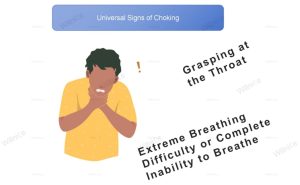
Choking can be a frightening experience, and, thus requiring immediate action. Start by asking the distressed person whether they are choking. If one does not hear a reply and all they are doing is shaking their head, there is a big possibility that person is indeed not able to cough or speak. For children over one year and adults patients, the advice is first the heimlich maneuver. For this, stand behind the individual, wrap your arms around their waist and tighten your hold by making a fist with one of your hands. The other hand will then grasp this fist which will be held up thumbs side just above the belly bottom of the other person. The thumb-side of the fist will be placed a short distance above the belly bottom of the person. Now, push your fist upward at a right angle to the body up to a distance of the width of your shortest cane and repeat this ‘Up and Thrust’ motion until the food you are trying to retrieve is dislodged.
If a person collapses, they should be lowered to the ground careful. Ensure that you call for help and start the procedure of CPR while concentrating on chest muscle compressions which are 100 to 120 per minute. In case of babies who are less than one year old, hold their neck and head and lie the child on your lap such that the baby is face down, then use the heel of your palm to hit the middle of the baby’s back five times. If the obstruction doesn’t disappear, put the child on their back, using two fingers apply pressure on the center of the chest just below the breast bone for five times while rotating your wrist gently with relief motions. Continue performing the procedure until the object is dislodged.
Steps to Perform the Heimlich Maneuver
To perform the Heimlich maneuver effectively, position yourself behind the choking person and wrap your arms around their waist. Make a fist with one hand and place the thumb side just above the person's navel, grasping it with your other hand. Execute upwards abdominal thrusts with a forceful motion. Continue until the obstruction is expelled. In a situation where the person has lost consciousness, gently lay them on the ground and call emergency services immediately, then perform CPR with emphasis on chest compressions. If performing these steps on an infant or young child, use less force and adapt the technique by using gentle back blows and chest thrusts, ensuring their safety throughout each step. Medical assistance should be sought immediately after a choking incident to prevent complications.
Using Back Blows and Abdominal Thrusts
As someone who has researched extensively on using back blows and abdominal thrusts, I understand their importance in responding to choking emergencies. When I perform these techniques, I’m careful to position myself correctly behind the choking person and deliver firm yet controlled thrusts to dislodge the obstruction effectively. Back blows can be crucial, especially when dealing with infants. I make sure to support their head and neck while delivering gentle blows between their shoulder blades. This dual approach of back blows and abdominal thrusts is something I consider vital for ensuring the choking individual receives immediate relief, while always prioritizing safety and seeking medical advice afterwards.
When to Perform Chest Thrusts for a Choking Person
By doing abdominal trust while standing or while sitting, I know that it is time for chest thrusts. This may happen for some pregnant or overweight people during the time abdominal trusts are not effective or cannot be performed. So, what I do is ensure that the patient is in a sitting or standing position. Then I come behind them and fully wrap my arms around their chests. It is necessary to make quick inward thrusts. The reason for this is that I rest my balled up fist in between their chest and the xiphoid process. This method can be helpful if other methods do not work. The key point to remember is that as soon as this has been accomplished, I notify emergency services and supervise the person while doing this.
What to Do if a Choking Person Becomes Unconscious?
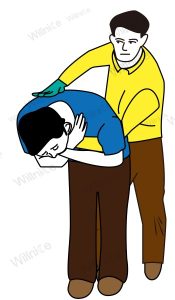
If a choking person becomes unconscious, it's crucial to act quickly and calmly. First, carefully lower the individual to the ground, ensuring their safety and preventing injury from a fall. Next, call emergency services immediately or direct someone nearby to do so, as professional medical assistance is critical. Begin cardiopulmonary resuscitation (CPR) by performing chest compressions. Make sure the head is tilted back slightly to open the airway, and after every 30 compressions, attempt to give two rescue breaths. If possible, check the mouth for any visible obstruction. Continue these actions until professional help arrives or the person regains consciousness. Remember, your prompt actions can make a significant difference.
Administering CPR for a Person Who is Unconscious
Administering CPR for a person who is unconscious requires precise actions and calmness. First, ensure the environment is safe for both you and the individual. Gently lower the person to the ground and call for emergency medical services immediately. Once the scene is secure, assess for breathing and check responsiveness by tapping the person's shoulder and shouting their name. If there is no response, begin CPR immediately. Using the heel of your hand, place it in the center of the person's chest, cover it with your other hand, and interlock your fingers. Press down hard and fast, aiming for a rate of 100 to 120 compressions per minute, and allow for full chest recoil between compressions. After 30 compressions, open the airway by tilting the head back slightly and lifting the chin before providing two rescue breaths. Ensure each breath lasts one second, watching for chest rise to confirm air is entering. Continue cycles of chest compressions and rescue breaths until emergency help arrives or the person shows signs of regaining consciousness. These critical steps are life-saving and can significantly increase the chances of survival.
Steps Before Help Arrives
While waiting for help to arrive after initiating CPR, there are several essential actions you can take to support the individual’s chances of survival. Maintain communication with emergency services to provide updates on the person's condition and follow any additional instructions they might offer. Keep the environment as safe and comfortable as possible, protecting the person from extreme temperatures and ensuring there are no obstructions hampering their airway. If there are others present, ask them to assist by monitoring the individual's pulse or helping with CPR to prevent fatigue. Stay calm and focused, ensuring that your compressions remain consistent in depth and rate. Continuous monitoring of the person's responsiveness and signs of recovery is vital, as it may help emergency personnel assess the situation better upon their arrival. Remember, your calm demeanor and adherence to CPR protocols are crucial during this time.
How to Prevent Choking in the First Place?
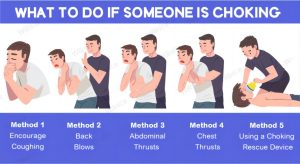
To prevent choking, it is important to take several proactive measures, particularly with young children and elderly individuals who are more susceptible. Firstly, ensure that food is cut into small, manageable pieces and encourage thorough chewing before swallowing. Avoid talking or laughing with food in your mouth, as this can lead to accidental inhalation of food particles. Additionally, avoid giving hard, small foods such as nuts, grapes, or hard candies to young children. Supervise meal times to promote safe eating habits. In homes with small children, keep small objects and toys that can be potential choking hazards out of reach. Adopting these precautionary measures can significantly reduce the risk of choking incidents.
Identifying and Reducing Choking Hazards
To effectively identify and reduce choking hazards, I first focus on the environment, ensuring it is free of small, loose items that could easily be swallowed. I regularly inspect toys and household items for any parts that might pose a risk, particularly for children under five. When it comes to food, I make sure to prepare meals thoughtfully by cutting food into small, appropriate sizes and teaching thorough chewing before swallowing. I also try to avoid serving high-risk foods like whole grapes or hard candies to young children. Through vigilant supervision during meals and playtime, I can proactively address potential hazards, providing a safer environment for those in my care.
Tips to Prevent Choking in Children and Adults
It is possible to properly prepare, cut foods and serve them in adequately sized portions while keeping risk-prone objects away from children preventing the choking in both children and adults. During meals children and adults should be brisked against eating while talking, engaging in laughter during meals or doing any such activities. Habits of adults and supervision of young children and elder people are very crucial in preventing choking as certain foods such as popcorn, nuts or hard candy are potentially too hazardous especially when they are eaten carelessly. This carelessness might be present in children who are still in their getting-to-know-the-world phase where everything goes in their mouths.
What is the Role of First Aid Training in Choking Emergencies?
First aid training plays a crucial role in managing choking emergencies by equipping individuals with the knowledge and skills to act swiftly and effectively. During such emergencies, prompt action is vital, and trained individuals can perform essential techniques like the Heimlich maneuver or back blows to dislodge obstructions from the airway. First aid training provides people with confidence and competence in assessing the situation appropriately, contacting emergency services when necessary, and providing continual aid until professional help arrives. Ultimately, this preparedness can save lives, reduce panic in critical moments, and minimize the severity of choking incidents.
The Importance of First Aid Training
First aid training holds immense importance in effectively handling choking emergencies. Through training, I've learned how to quickly assess situations and apply techniques like the Heimlich maneuver or back blows to aid a choking individual. I understand that having these skills not only boosts my confidence in emergency situations but is critical for acting promptly and potentially saving lives. The training emphasizes the importance of remaining calm, ensuring that I can make the right decisions, such as contacting emergency services if needed. With this preparedness, I feel capable of reducing panic and effectively managing the severity of incidents, underscoring the life-saving potential of having first aid knowledge.
How First Aid for Choking Can Save Lives
First aid for choking can indeed save lives by enabling quick and effective action. When an individual is choking, the immediate application of techniques like the Heimlich maneuver or abdominal thrusts can dislodge blockages, restoring airflow and preventing severe outcomes. These methods are technical yet simple: stand behind the person, make a fist, place it slightly above the navel, and perform quick upward thrusts. Additionally, back blows can be introduced by standing behind the person, leaning them slightly forward, and delivering firm blows between the shoulder blades with the heel of your hand. Performing these maneuvers correctly requires proper training, which emphasizes the importance of calm decision-making and rapid response. Ensuring that an emergency service is contacted if the obstruction isn't cleared quickly is paramount. By mastering these techniques, one can significantly reduce panic, manage the incident effectively, and increase the chances of survival.
References
Frequently Asked Questions (FAQ)
Q: What should you do if you think someone is choking?
A: If you think someone is choking, first ask them "Are you choking?" If they cannot speak or breathe, you need to act quickly. For a person who is conscious and choking, use the Heimlich maneuver to dislodge the object causing the obstruction.
Q: How do you perform the Heimlich maneuver on a choking adult?
A: To perform the Heimlich maneuver on a choking adult, stand behind the person, wrap your arms around their waist, and make a fist with one hand. Place the thumb side of your fist against the middle of their abdomen, just above the navel. Grasp your fist with your other hand and perform quick, upward thrusts until the foreign object is expelled.
Q: What steps should be taken if a child is choking?
A: To stop a child from choking, kneel behind them and perform the Heimlich maneuver similarly to an adult, but more gently. If the child is under one year old, give five back slaps followed by five chest thrusts, ensuring to support the child’s head and neck.
Q: What actions should be taken if the choking person is unconscious?
A: If the person is unconscious, call emergency services immediately. Begin cardiopulmonary resuscitation (CPR) if trained, as it may help dislodge the object and provide life support until help arrives.
Q: How can you assist yourself if you are alone and choking?
A: If you are alone and choking, try to perform thrusts on your own abdomen using your hands or lean over a firm object such as the back of a chair, applying pressure to your abdomen to dislodge the object.
Q: What is the role of the American Red Cross in choking treatment and prevention?
A: The American Red Cross provides training and education on emergency first aid, including choking treatment and prevention. They offer courses that teach how to recognize and respond to choking emergencies.
Q: How can choking on food be prevented?
A: Choking prevention includes cutting food into small pieces, chewing thoroughly, avoiding talking or laughing while eating, and keeping small objects out of reach of children. Supervising children during meals can also help prevent choking incidents.
Q: What should you do if you cannot see the object causing choking?
A: If you cannot see the object causing choking, do not perform a blind finger sweep as it may push the object further into the windpipe. Instead, continue with back blows and abdominal thrusts until the object is expelled or professional help arrives.
Q: Who invented the Heimlich maneuver and what is its purpose?
A: The Heimlich maneuver was invented by Dr. Henry Heimlich. Its purpose is to apply pressure to the abdomen to force air from the lungs through the windpipe, helping to dislodge the object that is causing choking.


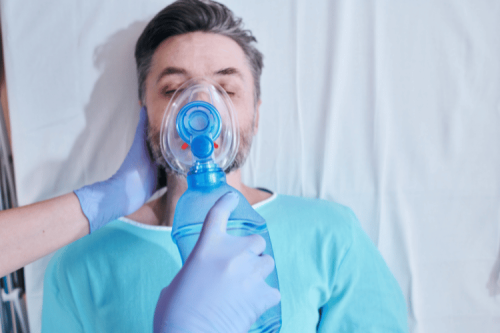
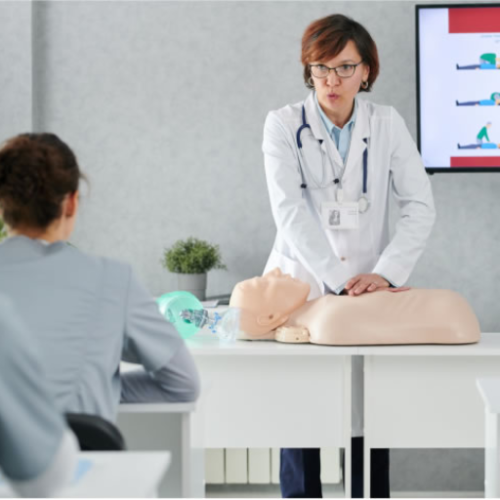
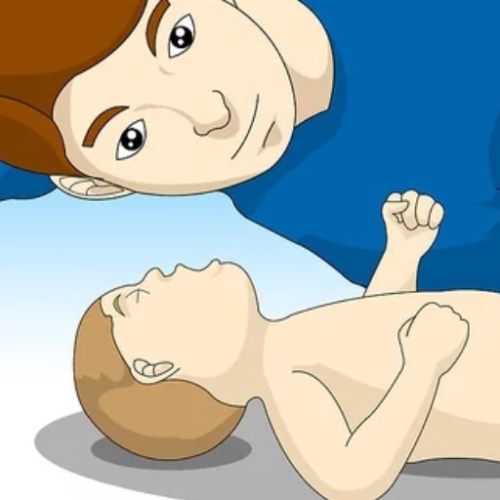

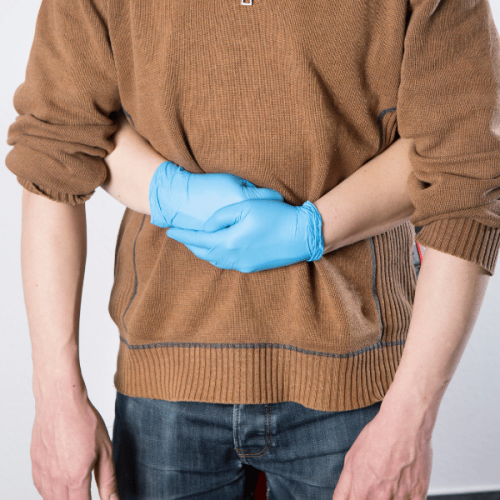
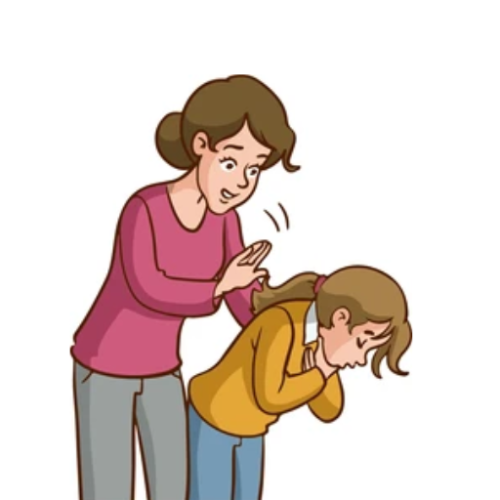
 Login with Google
Login with Google Login with Facebook
Login with Facebook